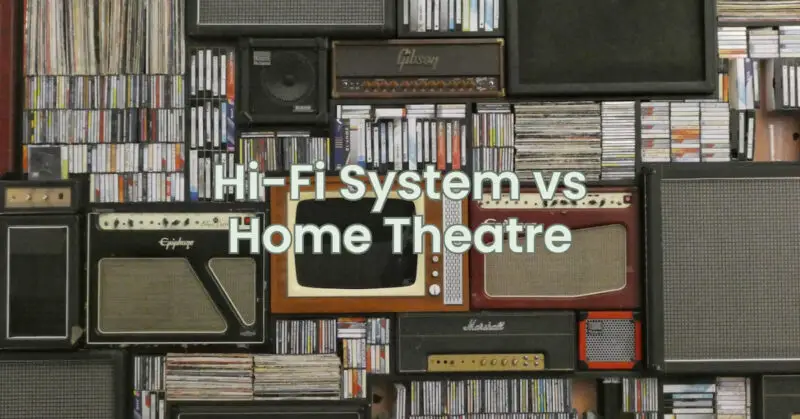When it comes to creating an exceptional audio experience at home, two popular options are hi-fi systems and home theatre setups. Hi-fi systems are designed to deliver accurate and high-quality sound reproduction for music enthusiasts, while home theatre systems aim to create an immersive cinematic experience for movie lovers. In this article, we will explore the distinctions between hi-fi systems and home theatre setups to help you understand the differences and choose the right audio solution for your needs.
Hi-Fi Systems: Hi-fi, short for high fidelity, refers to audio systems that prioritize accurate sound reproduction and the faithful playback of music recordings. Here are some key characteristics of hi-fi systems:
- Stereo Sound: Hi-fi systems focus on stereo sound reproduction, emphasizing accurate instrument placement and soundstage. They typically consist of two speakers – a left and right channel – to create a balanced and precise listening experience.
- Music Reproduction: Hi-fi systems prioritize the faithful reproduction of music, capturing the nuances, dynamics, and tonal accuracy of recordings. The goal is to reproduce music as close to the original recording as possible, providing an engaging and immersive listening experience.
- Hi-Fi Components: Hi-fi systems often involve separate components, including amplifiers, preamplifiers, CD players, turntables, or digital music streamers. These components are designed to work together to deliver optimal sound quality, allowing users to customize and fine-tune their setup based on personal preferences.
- Room Acoustics and Speaker Placement: Achieving optimal sound in a hi-fi system involves careful consideration of room acoustics and speaker placement. Proper placement of the speakers and room treatment can significantly enhance the soundstage, imaging, and overall listening experience.
Home Theatre Systems: Home theatre systems are designed to recreate a cinematic experience in the comfort of your own home. They prioritize creating an immersive environment with surround sound and audio effects. Here are some key characteristics of home theatre systems:
- Surround Sound: Home theatre systems utilize multiple speakers to create a surround sound experience. This typically includes front speakers (left, center, and right), rear speakers, and a subwoofer. The aim is to immerse viewers in the audio, enhancing the movie-watching experience.
- Movie and Sound Effects: Home theatre systems emphasize the reproduction of movie soundtracks and special effects. They are designed to handle dynamic and complex soundtracks, explosions, dialogues, and other cinematic audio elements with precision and impact.
- AV Receivers and Processing: Home theatre systems often include audio-video (AV) receivers, which serve as the control center for audio and video signals. AV receivers process and decode audio formats such as Dolby Atmos and DTS:X, enabling immersive surround sound experiences. They also provide connectivity options for various source components and video displays.
- Room Acoustics and Speaker Placement: Proper placement of speakers and room acoustics are crucial for home theatre systems. Strategic placement and calibration of speakers ensure accurate sound positioning and balanced audio distribution, optimizing the surround sound experience.
Choosing the Right Setup: Choosing between a hi-fi system and a home theatre setup depends on your primary audio preferences and usage. Consider the following factors:
- Music vs. Movies: If your primary focus is music enjoyment and faithful sound reproduction, a hi-fi system is the ideal choice. If you prioritize immersive movie experiences with surround sound and audio effects, a home theatre system is more suitable.
- Room Size and Acoustics: Consider the size and acoustic characteristics of your listening space. Hi-fi systems can work well in various room sizes, while home theatre systems may require more space due to multiple speakers. Room treatment and speaker placement are essential for both setups.
- Personal Preferences: Your personal audio preferences and the type of content you enjoy most will influence your choice. Consider whether music or movies are more important to you and which setup aligns with your listening priorities.
- Budget and Flexibility: Hi-fi systems can range from entry-level to high-end setups, allowing for flexibility based on budget constraints. Home theatre systems often involve more components and speakers, which can increase costs. Consider your budget and desired level of customization.
Conclusion: Hi-fi systems and home theatre setups serve different audio purposes and cater to specific preferences. Hi-fi systems prioritize accurate music reproduction and stereo imaging, delivering an immersive and faithful music listening experience. Home theatre systems prioritize creating an immersive cinematic experience with surround sound and audio effects. Understanding the distinctions between these setups allows you to choose the audio solution that aligns with your preferences and provides an enjoyable and engaging audio experience, be it immersing yourself in the beauty of music or recreating the excitement of a movie theatre at home.


